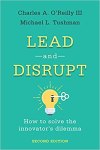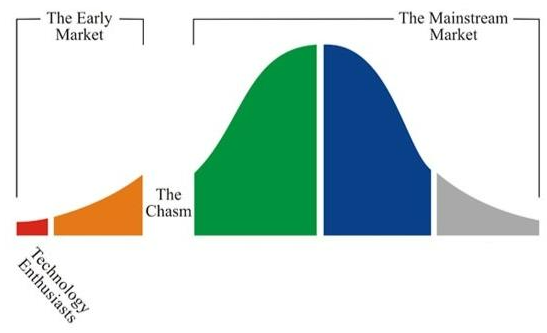[ad_1]
You think startups are hard? Try innovating inside a large company where 99% of the company is executing the current business model, while you’re trying to figure out and build what comes next.
Charles O’Reilly and Michael Tushman coined the term an “Ambidextrous Organization” to describe how some companies get this simultaneous execution and innovation process right. Their book Lead and Disrupt describes how others can learn how to do so.
I was honored to write the forward to their second edition. Here it is in its entirety.
What you’re holding in your hand is a revolutionary document. It answers the questions of why some companies trace a brilliant arc as a shooting star and then flame out while others continue to thrive. Why are some companies able to reinvent themselves while others, once market leaders, are disrupted?
Is it that some CEOs are better than others? Are their people smarter? Do they have better sales, marketing, or product development groups?
The short answer is no. What the winners start with is the realization that in a world of continuous disruption, they have only a few years to develop new capabilities or be pushed over the brink. And they also recognize that simply exploiting Their existing assets, capabilities, and business models are insufficient for long-term survival. So they prepare for future markets by exploring new ventures.
This radical idea of companies continuing to execute and exploit their existing business model while simultaneously exploring and creating new products, businesses, and business models is what O’Reilly and Tushman call ambidexterity. While simple at first glance, the concept is revolutionary in its ability to transform an enterprise. This book not only explains the “why does this happen” but more importantly gives you the tools for “what to do about it.”
In the 20th century, finding the successful formula for repeatable start-up success remained a black art. The idea of exploitation versus exploration was central in my own work in building the lean methodology for start-ups. The key was the realization that start-ups are not simply smaller versions of large companies, which execute /exploit known business models, and whose customers, problems, and necessary product features are all “knowns.” In sharp contrast, start-ups operate in “search /explore”Mode, seeking a repeatable and profitable business model. The search for a business model requires dramatically different rules, roadmaps, skill sets, tools, and culture in order to minimize risk and optimize chances for success.
Recognizing the anomaly was just the first step. There were no standard tools, methods, or playbooks for start-ups. So we built our own tools to enable founders to rapidly translate their vision into hypotheses and then into validated facts. These tools — Customer Development, Agile Engineering, and Business Model design — became the lean start-up methodology, a rigorous approach to testing hypotheses and building prototypes, and, on the basis of data and evidence, adjusting or pivoting to a variant of the original hypothesis. Today, lean is the de facto method for building new start-ups.
Fast forward two decades, and many companies have adopted these start-up tools and methods to deal with disruption. However, after watching innovators in large companies try to use the lean start-up methodology, I’m embarrassed to say that it has mostly devolved into standalone innovation activities (corporate incubators, accelerators, and so on) resulting in “innovation theater,” with nice coffee mugs and posters but little impact on the top or bottom line.
In this book O’Reilly and Tushman succinctly articulate why these tools succeed in start-ups but fail in large companies. Most R&D budgets in established companies are spent on sustaining innovations that support existing products and operating divisions and the attendant processes and procedures, rigorous measurement, and controls. These formalized structures, necessary for managing execution / exploitation, actually strangle disruptive innovation before it can start.
Companies built around exploitation emphasize efficiency, productivity, and the reduction of variance, whereas exploration demands searching, discovering, and accepting risk and failure. To accomplish both simultaneously — to be an ambidextrous company—Requires not only separate organizations for each function, but also different business models, competencies, systems, processes, incentives, and cultures. In short, it requires a different way not only to manage a company, but a different way to organize it as well.
This is a really big idea.
To be truly successful at ambidexterity firms must master the new skills of ideation, incubation, and scaling. Firms first generate new ideas via ideation: the last twenty years have seen an explosion of corporate venture capital, open innovation, and employee involvement via hackathons and incubators. A smaller number of companies have become proficient at the next step—incubation—Rigorously testing new business concepts, using the lean start-up methods of Customer Development, Agile Engineering, and Business Model design. However, relatively few have successfully scaled new internal ventures to enable them to stay ahead of disruption. It is this discipline of scaling, actually building new, substantive, profitable businesses, that is critical to the success of new, highly innovative corporate ventures. It’s only when companies can scale that they truly win. Scaling is the crux of ambidexterity.
Recognizing the need for ambidexterity and building an ambidextrous organization are tests of corporate leadership.
In the end, exploitation pays your salary while exploration pays your pension. Companies that survive do both.
This book will do for companies what the lean methodology did for start-ups – give its leaders the essential playbook for transforming their organizations to meet the future.
Get your copy of Lead and Disrupt.
Filed under: Customer Development |
[ad_2]
Source link


